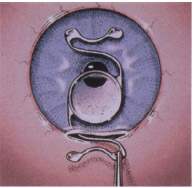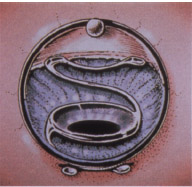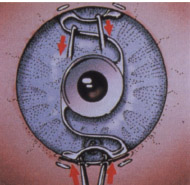The NuVita Angle Supported Phakic Intraocular Lens
CHAPTER CONTENTS
The original Baikoff anterior chamber intraocular lens (AC IOL) design that was first introduced in 1989 included an anterior vault, 4.5-mm optic diameter, and four-point haptic fixation. This phakic IOL was essentially a modification of the successful Kelman AC IOL used for aphakic eyes. The next generation of the Baikoff IOL (NuVita MA20; Bausch 5c Lomb, Rochester, NY), which is now being used, has an improved footplate design to decrease pupil ovalization and an increased optic zone from 4.0-mm to 4.5-mm (5.0-mm optic width overall). Peripheral detail treatment (PDT) has been used to modify the 5.0-mm optic edge to decrease edge glare and halos.
Advantages
- decreased potential aberrations (corneal contour left prolate)
- accommodation left intact
- almost complete reversibility
- lower cost than excimer laser procedures
- greater success than corneal refractive procedures for correcting higher refractive errors
Disadvantages
- potential intraocular complications
- endophthalmitis
- corneal endothelial damage
- intraocular inflammation
- cataract
- endophthalmitis
- fewer study results
- need for an intraocular surgical facility
- current inability to correct astigmatism
PREOPERATIVE CONSIDERATIONS
Indications
- extreme myopia or hyperopia (myopia > −10 to −12 D; hyeropia > +4 to 6 D)
- cases in which laser in situ keratomileusis (LASIK) is contraindicated
Inclusion Criteria
- AC depth greater than 3.0 mm
- patient age 25 to 45 years old
- patient comfort with surgical risks
- reasonable patient expectations about results
Patient Evaluation
- Determine monocular and binocular, corrected and uncorrected, distance and near visual acuity.
- Measure manifest and cycloplegic refraction.
- Do not rely on patient’s habitual spectacle power as the manifest refraction because high myopes are frequently over minused (see Chapter 4).
- Perform topography and keratometry.
- Ensures that astigmatic power and axis coincide with manifest refraction astigmatic power and axis.
- Helps to plan placement of limbal relaxing incisions (LRIs) to correct astigmatism when implanting the phakic IOL (see Chapter 8).
- Ensures that astigmatic power and axis coincide with manifest refraction astigmatic power and axis.
- Perform a slit-lamp examination (rules out or identifies corneal disease and anterior segment pathology or inflammation).
- Measure the horizontal white-to-white limbal distance (add 0.5-1.0 mm to corneal diameter to determine the overall size of the NuVita IOL).
- Measure the length of the eye with an A-scan.
- This measurement is not necessary for phakic IOL implantation (phakic IOL is an additional lens, not a replacement but may be helpful later for future cataract extraction and determination of AC depth).
- Use a current applanation or immersion A-scan [identifies AC depth (>3.0 mm is needed) to determine the safety of phakic IOL implantation].
- This measurement is not necessary for phakic IOL implantation (phakic IOL is an additional lens, not a replacement but may be helpful later for future cataract extraction and determination of AC depth).
- Measure intraocular pressure (IOP) (21 mmHg is a risk factor for glaucoma).
- Perform gonioscopy (rules out AC angle abnormalities such as peripheral anterior synechiae, which could complicate implantation of the phakic IOL into the angle).
- Examine the dilated fundus.
- Rules out any severe, progressive, or inflammatory vitreal or retinal pathology.
- Identifies any peripheral retinal degeneration, holes, or tears (may be safely treated with focal or barrier laser photocoagulation before phakic IOL implantation).
- Rules out any severe, progressive, or inflammatory vitreal or retinal pathology.
- Perform ultrasound biomicroscopy (UBM) (obtains more accurate measures of AC depth and exact configurations of AC anatomy).
- Have several different-sized implants on hand so they may be exchanged quickly if necessary.
- Determine the amount of diopter power needed.
- Gather data obtained during patient evaluation.
- Consult the nomogram or formula provided by the manufacturer of the AC phakic IOL that is to be implanted [e.g., the NuVita phakic IOL (model MA20) nomogram by Bausch 6c Lomb] (Fig. 14–1).
- Gather data obtained during patient evaluation.

Figure 14-1 The NuVita phakic intraocular lens (model MA20), an AC, angle-fixated phakic IOL.
SURGICAL CONSIDERATIONS
Relative Contraindications
- amblyopia
- monocularity
- iris atrophy
- untreated peripheral retinal lattice degeneration, holes, or tears
- endothelial cell count less than 2500 cells/mm2 (procedure itself may cause a loss of 8-10%, followed by 1% per year)
- glaucoma
Absolute Contradictions
- inflammation of anterior or posterior segment
- corneal dystrophy or scars that reduce best corrected visual acuity
- iris rubeosis
- significant or progressive retinal pathology
- microphthalmia
- cataracts
- regular patient participation in violent or high-contact sports (e.g., boxing, karate, and football)
Equipment
- forceps
- steel or diamond keratome
- viscoelastic substance (ensures adequate formation of the AC by protecting the endothelium)
- goniolenses (ideally, Thorpe- and Zeiss-type goniolenses)
- Kuglen hook (recommended but optional)
- cystitome (recommended but optional)
Methods
- Gently massage the eye or place a Honan balloon on the eye for a 5 to 10 min to soften it.
- Measure (or remeasure) the white-to-white corneal limbal distance.
- Instill several drops of pilocarpine 1 to 4%.
- Topical (proparicaine 0.5%) or local anesthesia (lidocaine 2%) is preferred, but general anesthesia may be used.
- Create a temporal, self-sealing, 5.5-mm clear corneal incision that has a groove and a 1.5-mm tunnel into the AC.
- Immediately insert a viscoelastic substance (Healon or Provisc; Alcon, Fort Worth, TX or Occucoat; STAAR Surgical Co., Monrovia, CA), but avoid introduction of any viscoelastic substance behind the iris.
- Position yourself to the side of the patient’s head.
- Hold the closest (superior) edge of the implant with forceps.
- Snake the leading (lower ox farthest) haptic into the AC (do not touch the anterior lens capsule or the corneal endothelium).
- Continue to hold the superior (closest) edge of the implant with forceps.
- Guide the implant across the iris until both ends of the lower (leading) haptic are in the angle.
- Ensure that the pupil is still round and not deformed or ovalized.
- Verify that the trailing (closest) haptic is still outside the AC (if already inside the eye, the implant is too small).
- Grasp the elbow of the trailing haptic with forceps to push the lens across the AC without tucking the iris (may avoid full insertion of the implant into the eye if the IOL is too small) (Fig. 14-2).
- Place a Thorpe-type goniolens and a viscous-substance cushion on the cornea.
- Carefully ensure there is no iris tuck (causes ovalization of the pupil) (Fig. 14-3).
- Resolve any iris tuck before placing the remaining (trailing) haptic in the angle (reduces the risk for hyphema).
- Grasp the trailing haptic just under the edge of the right footplate using forceps.
- Gendy press the right haptic into the eye (direct it downward so that it springs back under the cornea).
- Retract the posterior edge of the incision with a Kuglen hook.
- Insert the left end of the trailing haptic with forceps and allow the haptic to spring back under the posterior lip of the wound.
- Place a fork-shaped or collar-button IOL manipulator into the curve of the bridge between the two footplates of the trailing haptic.
- Alternatively, a surgeon may push both footplates into the AC and under the posterior lip of the wound (avoids the need for another hand to pull the wound open and avoids placing forceps into the eye a second time).
- Again, ensure there is no iris tuck by using a Zeiss-type goniolens to visualize the trailing haptic ends.
- Verify that the leading haptics have not been displaced by insertion of the trailing haptics using a Thorpe-type goniolens and viscous substance cushion.
- If the leading haptics are positioned incorrectly, use a lens hook (or cystitome) to retract and reposition them.
- If the trailing haptics are positioned incorrectly, use a Kuglen hook to push the haptic away from the angle and then release it (Fig. 14-4).
- Again, verify correct positioning of the haptics using a goniolens.
- Place an optional iridotomy one fourth of the distance from the angle to the center of the pupil and midway between the ends of the trailing (closest) haptics.
- Place one or two sutures across the wound (do not tie them).
- Gently and slowly irrigate and aspirate viscoelastic substance to avoid displacing the implant.
- Tie the sutures.
- Make a final gonioscopic evaluation after closing the incision.
- Retract the posterior edge of the incision with a Kuglen hook.



Potential Alternative Treatments
- glasses
- contact lenses (soft or rigid-gas permeable)
- LASIK (see Chapter 11)
- photorefractive keratectomy (PRK; see Chapter 9)
- clear lens replacement (see Chapter 13)
POSTOPERATIVE CONSIDERATIONS
Mild Complications
- inflammatory reactions
- anterior subcapsular vacuoles
- early pupillary block
- cataracts
Moderate Complications
- halos and glare (subjectively mild, moderate, or severe)
- ovalization or distortion of the pupil
- progressive or nonprogressive
- 7 to 30% overall incidence
- caused by an IOL that is too large
- progressive or nonprogressive
- endothelial cell count reduction (usually parallels normal cell count reduction of 0.5-1.0% per year but may be progressive)
- footplate caught in peripheral iridectomy
- implant displacement or rotation (usually apparent within 3-18 months)
- potential glaucoma from long-term angle damage
Severe Complications
- endophthalmitis
- retinal detachment (no evidence of increased risk with phakic IOL insertion)
Prevention and Management of Complications
- Most inflammatory reactions, early pupillary block, and anterior subcapsular vacuoles resolve spontaneously with little or no intervention.
- Hypotony and early pupillary block associated with Seidel’s sign that do not resolve in 24 hr require reopening the corneal incision and resuturing the wound.
- glare or halos
- Most complaints decrease by an estimated 33% over the first 1 to 3 months, or the patient begins to tolerate the symptoms.
- Prescribe low-dose pilocarpine (0.125-1%) at night.
- Explant the lens if symptoms are persistent or severe.
- Most complaints decrease by an estimated 33% over the first 1 to 3 months, or the patient begins to tolerate the symptoms.
- ovalization or distortion of the pupil
- Carefully monitor the iris during implantation.
- Carefully choose the size of the implant.
- Do not push too hard on the iridocorneal angle with the footplates.
- Move the lens farther forward if distortion is too progressive.
- Carefully monitor the iris during implantation.
- endothelial cell count reduction
- Maintain formed AC with viscoelastic substance to avoid touching endothelium.
- Select the proper size of implant (an IOL that is too small may lead to pseudophakodonesis, which causes significant direct contact and mechanical trauma to endothelium).
- Explant lens if lens reduction is too progressive.
- Maintain formed AC with viscoelastic substance to avoid touching endothelium.
- footplate caught in the peripheral iridectomy
- Do not place the iridectomy below the area covered by the upper lid.
- Surgically correct by repositioning the haptic.
- Do not place the iridectomy below the area covered by the upper lid.
- Implant displacement or rotation requires surgical repositioning.
- Use prophylactic antibiotics intraoperatively to prevent endophthalmitis.
- retinal detachments
- Pretreat suspicious areas of lattice degeneration with focal laser or barrier laser around the full periphery.
- Treat with photocoagulation or cryopexy.
- Pretreat suspicious areas of lattice degeneration with focal laser or barrier laser around the full periphery.
Enhancements and Secondary Procedures
LASER IN SITU KERATOMILEUSIS Perform LASIK to correct residual spherical or cylindrical error (see Chapter 11 for procedural details). With the NuVita AC IOL, perform the keratectomy of the LASIK before inserting the phakic IOL because the proximity of the AC lens to the endothelium may result in endothelial damage when the cornea is flattened during the keratectomy. Jose Guell named this approach the “adjustable refractive surgery” or ARS concept. After inserting the NuVita lens and refraction is stable, the surgeon lifts the flap and performs the refractive excimer laser “enhancement.”
LIMBAL RELAXING INCISIONS Create LRIs to correct residual astigmatism of 2.50 to 3.00 D. Place LRIs simultaneously with implantation of a phakic IOL. (See Chapter 8 for details about the procedure.)
PHAKIC IOL EXCHANGE AND POSSIBLE SIMULTANEOUS REMOVAL OF THE NATURAL LENS If the NuVita phakic IOL causes disabling visual problems (e.g., glare or halos) or persistent ocular complications (e.g., progressive endothelial cell loss or cataracts), then the surgeon should remove it. In many cases, repositioning or replacement of the lens with a better-sized one corrects the problem. With a cataract, the NuVita IOL needs to be removed and a standard cataract extraction procedure performed followed by insertion of an IOL in the capsular bag.
Methods
- The most common choice is a local ocular anesthetic (lidocaine 2-4%), but general anesthesia may also be used.
- If only phakic IOL explantation is required (no cataract), then instill two drops of pilocarpine.
- Inject viscoelastic into the eye and continue as noted below.
- If planning explantation of the phakic IOL and simultaneous removal of the natural lens, do the following.
- Induce preoperative mydriasis.
- Remove the cataract through a 3-mm clear corneal incision to maintain the stability of the AC.
- Proceed with the capsulorrhexis using forceps.
- Evulse the nucleus.
- Clean and aspirate the cortex (should be easy because the natural lens has a soft texture).
- Wait until the end of the procedure to extend the incision for explanting the IOL or implanting a new, lower power,posterior chamber implant.
- Induce preoperative mydriasis.
- Depending on the quality of the capsulorrhexis, fix the implant in the capsular sac or to the ciliary sulcus.
- Perform paracentesis of the AC at the initial point of incision.
- Inject sufficient viscoelastic substance into the AC in front of the implant to deepen the AC.
- Simultaneously depress the lower lip of the paracentesis to allow aqueous outflow.
- Extend the corneal incision to 6 mm with a scalpel or diamond knife (if planning to perform simultaneous clear lens replacement surgery with phakic IOL extraction, wait until the end of the procedure to extend the corneal incision).
- Dislodge the implant from the iridocorneal angle opposite the incision with forceps.
- Replace or remove the implant, and completely remove all viscoelastic substance.
- Close the corneal incision (without leaks) with 10-0 nylon sutures.
- Dislodge the implant from the iridocorneal angle opposite the incision with forceps.
Postoperative Care
- Prescribe combination antibiotic/steroid drops (Tobradex; Alcon) four times a day on a slow taper that decreases by one drop a day per week.
- Instruct the patient to wear an ocular shield at night for 5 to 7 days.
- Prescribe preservative-free artificial tears for 1 to 2 weeks, as needed.
Follow-Up
- Examine patients at day 1; weeks 1, 3, and 6; and 12 months.
- Monitor endothelial cell count and compare with preoperative measurement at 3, 6, and 12 months.
- The minimum threshold for explanation of a phakic IOL is a 50% decrease in endothelial cell count because chances are good for maintaining corneal transparency throughout life with 50% of original endothelial cell count.
- Monitor IOP, all anterior segment parameters, the presence or absence of inflammation, the condition of the pupil, the iris, the iridocorneal angle, and the clarity of the natural lens.
- Monitor refraction (if refractive error significantly affects visual performance, consider phakic IOL exchange).
- Monitor the posterior pole and peripheral retina annually.
Suggested Readings
Baikoff GD. Refractive phakic intraocular lenses. In: Elander R, Rich LR, Robin JB, eds. Principles and Practice of Refractive Surgery. Philadelphia: WB Saunders Company; 1997: 435-447.
Baikoff G, Arne JL, Bokobza Y, et al. Angle fixated anterior chamber phakic intraocular lens for myopia −7 to −9. J Refract Surg. 1998;14: 282-293.
Wu HK, Thompson VM, Steinert R, Hersh PS, Slade SG. Refractive Surgery. New York: Thieme Medical Publishers, Inc.; 1999.
< div class='tao-gold-member'>



